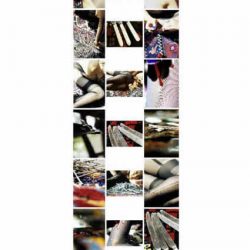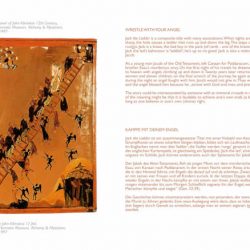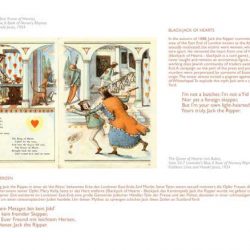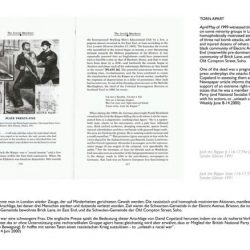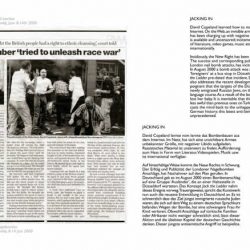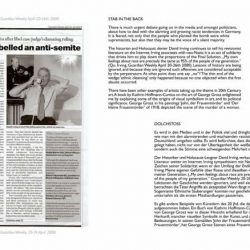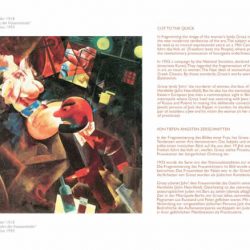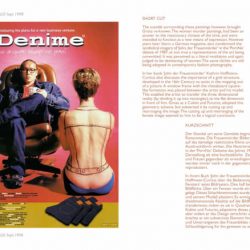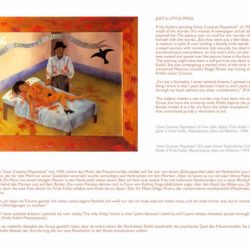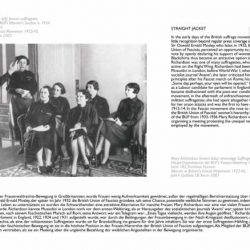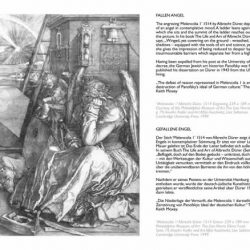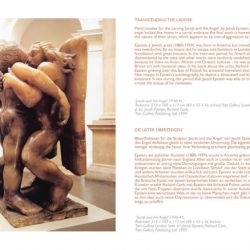21 photo series in a ladder-shape 3,5 metres high, C‑prints mounted on Forex and sealed, glass and clip frame: 7 photos 27 x 40 cm, 14 photos 40 x 50 cm, edition of 7
Insurance value 3,000 Euros
The photo series Jack the Ladder is also available in a smaller version: 14 Photos 13 x 18 cm, 7 Photos 19 x 13 cm, edition of 7.
A series of 12 texts with images have been prepared by the artist to accompany the photo series (2000−03); these posters inform the spectator of motivation and background to the artwork.
Jacob’s Ladder – a collection of works:
- Roman Svastika
- Tantric Snakes and Ladders
- Jacob’s Ladder – a Cybersexual Parable
- Franco and Elke J.
- Fashion Victim
- Barbie and Klaus
- Jacob’s Ladder
- Swastikas and Stars
- wrestlewithyourangel
- neonazi
- Blind Spot
- Red Hot Pokers
- Transcending the Ladder
- Jack the Ladder
Jack the Ladder is a 21 photograph series displayed in a ladder shape (a vertical ladder with 7 rungs over 3.5 metres high). The portrait of a young Chinese woman Echo-Ho is depicted in fragmented images. Apart from wearing black tights, she is naked and photographed against a pre-dominantly red-coloured, oriental carpet. She has been painting her fingernails. There are runs in her nylons (ladders) stopped with drops of red nail varnish, which may, on the other hand, be drops of blood. In some of the photos piles of steel nails can be seen, in others broken glass and a set of five antique English fruit knives with pearl handles.
Jack the Ladder commemorates the victims of racial and sexual intolerance present and past: the London nail bomb attacks of 1999 and the ‘Jack the Ripper’ killings a hundred years earlier.
Presentation
2000 Aesthetik 1,2,3, 68Elf Galerie, Photoszene Cologne (D)
2003 Das Recht des Bildes, Jüdische Perspektiven in der Modernen Kunst (The Right of the Image, Jewish Perspectives in Modern Art), Museum Bochum (D)
Press
Against Media Idolization, Peter V. Brinkemper, Telepolis 2004
Tanya Ury, the Anglo/German artist, who lives in Cologne, operates from poles between a media conscious present and the art historical archaic. She connects up biblical situations and modern art speak with contemporary social/political and explosive news about bomb attacks from London to Jerusalem. 21 photographs are put together in a “Ladder to Heaven” motif with seven steps, in “Jack the Ladder” (2000). It recalls Jacob’s vision of the Old Testament:
“He dreamt that he saw a ladder, which rested on the ground with its top reaching to heaven, and angels of God were going up and down it.” Genesis 28 (12)
The message of the visual fragments is everything other than heavenly however; the ladder collapses into a labyrinth of global suffering; the model and alter ego of the work, the young Chinese Echo Ho is a fallen angel, unclothed, unprotected and who, trapped between intimacy and terror, life and death, is a subject that in and for art, has become a victim of a virtual world, which can at any moment turn into bloody reality.
Article-URL: www.telepolis.de/deutsch/special/med/16440/1.html (Translation from German Tanya Ury)
The Right of the Image, Jewish Perspectives in Modern Art
Hans Günter Golinski, Sepp Hiekisch (D)(Hg.) 2003
Edition Braus ISBN 3−89904−0767
Hans Günter Golinski: To the Themes in an Exhibition, Page 25:
Somewhere in between taking sides and distancing themselves from a life in public. The paradoxical situation of artists from a Jewish background, which ranges from normal to being a special case, furnishes them with a sharpened consciousness that distances them to society at large and makes them aware of the conditions of minorities. Closely connected with the above aforementioned traditions and the practice of political wakefulness in their artistic creativity, artists like Leon Golub and Nancy Spero express an unmistakable social-political credo in their works, in that they bring home injustices with commitment, thereby forcing the spectator to position themselves and act. The same goes for representatives of a younger generation such as Komar & Melamit, Maxim Kantor, Moshe Gershuni, Menashe Kadishman, Penny Yassour, Roee Rosen or Tanya Ury.
(Translation from German TU)
Dr. Christoph Kivelitz, Page 276 – 277:
Tanya Ury looks to portray historical, cultural and semantic connections in images and texts with the closest care to detail, in order to create a complex tableau, employing various media.
‘Jack the Ladder’ (2000), a 21-piece photo series by Tanya Ury is presented in the form of a 3.5 meter-high ladder with seven steps. The basic form of the ladder consists of a montage of fragmented images, that from various angles convey the portrait of a young Chinese woman, Echo Ho, here also as a figure for the artist’s projection. The woman raises herself up from an oriental carpet that is principally red. Apart from black tights, she is completely naked and engaged in painting her fingernails red. Her nylons have runs. There is over and above the basic superficial form, a connection to the title, for instead of utilizing the word “run” — “ladder”, a far more vivid (English) word is employed here. She tries to fix them (the tights) with the application of nail varnish, thereby also awakening the impression of dripping blood. On some of the photos one can see steel nails, on others a set of five antique fruit knives with mother of pearl handles. These strengthen the association of wounding, or to be precise, of traces of violence. Accordingly an arc of tension is enfolded: the motif of the oriental carpet and the Chinese woman are to be interpreted as romantic, transfigured exoticism, as projections for fantasies of freedom and nomadic independence. The disorderliness of the pictures transmits a feeling of insecurity to the observer, and an ambiguity in the sense of surrealism or the ‘Carceri’ by Piranesi, hereby making imagined scenarios of fear and violence apparent. The black stockings, the nail varnish and the atmosphere of the space bring with them a sense of the erotic, so that the thematic of the used and abused woman, whose wounds, inflicted by the monster Jack the Ripper, can hereby also be read as the stages of a female Passion. The work is presented alongside a group of cited images and text commentaries that recall victims of contemporary and past racist and sexual intolerance: the nail bomb attack in London of 1999 and the Jack the Ripper murders a hundred years earlier. The image of the young woman transports the viewer into the milieu of saleable love that, with these associations gains a concrete background. Diverse layers of meaning are woven together here. The motif of the Jacob’s Ladder makes reference to the biblical lines: “He dreamt that he saw a ladder, which rested on the ground with its top reaching to heaven, and angels of God were going up an down it.” New English Bible, Genesis 28 (12).1 Beyond this the ladder also recalls traumatic memories and stories. The artist dreamt of the ladder motif repeatedly in childhood: “In those dreams, menacingly deep escalators tumbled and slid the traveller into an underworld, from turned-up-level steps. There were also shaky elevator constructions made of bare planks on building sites of Babel proportions.“2 For the artist, a descendant of the Berlin painter Lesser Ury, according to her own assertion, it is all about escaping the prescribed identity of her personal biography, more exactly the fact of her German-Jewish ancestors, who experienced the Holocaust first hand. She strives to confront this history, without shutting out her memory. “Signs”, according to Ury “are not only part of the collective unconscious, they also belong to a value system and are therefore symbols of a hierarchy, and a ladder…“3 Even the outward form dictates the rule of principal; the pictures themselves appear disordered, with alternately detail and close-up photos, with the tension between emotional effect and the cold, metal surface. The upward striving geometry of the Ladder to Heaven is brought to life, destroyed and with its winding image path and reference to the victim, wounding and repression, gains the dimensions of a labyrinth. The ladder, the stairs and the path upward stand in direct conflict with the run in the nylons, the destruction and the chaotic fringes of fabric. Apart from the ladder, the figure of Jack the Ripper is also the central connecting link. The notorious women murderer embodies the self-alienated culture of the Modern that from the perspective of National Socialist and other reactionary powers was defamed as “degenerate” and could be integrated into anti-Semitic smear campaigns. George Grosz saw the modern iconoclast and destroyer of values in this pathological figure, and with the knowledge of the fate and the flight of the Ury family, the Shoah might also be seen as a similar warning sign. In accordance with the diversely layered interpretations of the Talmud, the sequences of this photo cycle are explained by the already mentioned images of the placards with their literary quotations and narratives. In this way, historical artefacts, documents and tracks are uncovered in their cultural spectrum of meaning, in order to allow the very multiplicity of meaning, disharmony and unusualness to be made visible. The questioning of personal identity and history connects itself with the valiant discourse around a two-faced modernity, whose potential in politics, art and society, can appear as much emancipated as destructive.
(Translation from German TU)
